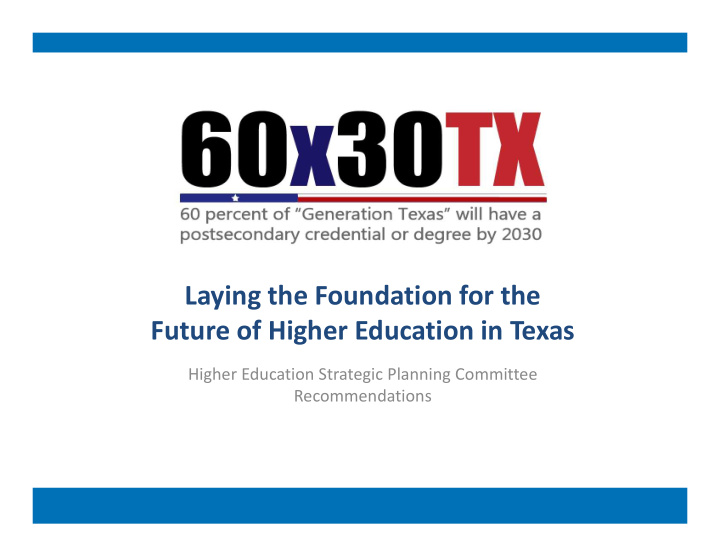



Laying the Foundation for the Future of Higher Education in Texas Higher Education Strategic Planning Committee Recommendations
Closing the Gaps by 2015 Progress on the four broad goals ‐ Participation : On track for 2014 target. Need about 45,000 more students to reach 2015 goal ‐ Success : Exceeded our goal. Highlight: In 2000, 1 in 5 completers were Hispanic; in 2014, this ratio was close to 1 in 3 ‐ Research : Surpassed target in FY 2008 with $3.1 billion in R&D expenditures ‐ Excellence : Texas programs and community colleges are nationally recognized
A New Texas Higher Education Strategic Plan Completion Marketable Student Skills Debt
60x30TX Builds on Achievements of CTG 2030 ‐ 2045 Plan
The 2015 ‐ 2030 PLAN HAS FOUR STUDENT ‐ CENTERED GOALS 60x30 Overarching Goal: By 2030, at least 60 percent of Texans ages 25-34 will have a postsecondary credential or degree. COMPLETI ON Goal: By 2030, at least 550,000 students in that year will complete a certificate, associate, bachelor’s, or master’s from a Texas public, independent, or for-profit college or university. MARKETABLE SKI LLS Goal: By 2030, all graduates from Texas public institutions of higher education will have completed programs with identified marketable skills. STUDENT DEBT Goal: By 2030, undergraduate student loan debt will not exceed 60 percent of first-year wage for graduates of Texas public institutions.
60x30 By 2030, at least 60 percent of Texans ages 25-34 will have a postsecondary credential or degree. Incrementally increase overall postsecondary attainment.
Our future workforce will demand even more postsecondary trained and educated workers In 1973, only 28% of all U.S. jobs required postsecondary education/skills. By 2020, 65% of all new jobs will require this level of education. 59% of all new jobs in Texas will require postsecondary training or education by 2020. Currently, 34% of Texans aged 25 ‐ 34 have an associate degree or higher. 2 11 Source: Georgetown University Center on Education and the Workforce, June 2013
COMPLETI ON Goal: By 2030, at least 550,000 students in that year will complete a certificate, associate, bachelor’s, or master’s from a Texas public, independent, or for-profit college or university. – Increase the number of Hispanic, African American, male, and economically disadvantaged completers. – Increase the percent of public high school graduates who enroll directly in a public institution of higher education.
MARKETABLE SKI LLS Goal: By 2030, all graduates from Texas public institutions of higher education will have completed programs with identified marketable skills. – By 2020, institutions will have created and implemented a process to identify and regularly update marketable skills for each of their programs, in collaboration with business and other stakeholders, and to communicate these marketable skills to students. – Maintain the percentage of students who are found working or enrolled within one year of earning a degree or certificate.
What is a marketable skill? Students exit from any degree program with a variety of skills. Marketable skills are those valued by employers that can be applied in a variety of work settings, including interpersonal, cognitive, and applied skill areas. These skills can be either primary or complementary to a major and are acquired by students through education, including curricular, co ‐ curricular, and extracurricular activities.
STUDENT DEBT Goal: By 2030, undergraduate student loan debt will not exceed 60 percent of first-year wage for graduates of Texas public institutions. – Maintain student loan debt at or below 60 percent of first ‐ year wage for undergraduate completers. – Decrease the excess semester credit hours that students attempt when completing an associate or a bachelor’s degree. – Work to limit debt so that no more than half of all students who earn an undergraduate degree or certificate will have debt.
The Consequences of Inaction
2030 Projected Change in Educational Attainment of Population Age 25 ‐ 64 (Same Attainment Rates by Race/Ethnicity Assumed) Slide 13 30 2012 2030 25.1 24.7 25 23.4 22.4 21.0 20 18.5 17.4 16.9 15 8.9 10 8.0 7.1 6.6 5 0 Less than High High School or Some College, Associate Bachelor's Graduate or School GED No Degree Degree Degree Professional Sources: Texas State Data Center Population Projections. U.S. Census Bureau, 2012 American Community Survey and 2010 ‐ 12 American Community Survey Three ‐ Year PUMS.
Projected Change in Personal Income per Capita per 25 to 64 Year Old Resident (with Same Attainment Rates by Race/Ethnicity) Slide 14 $40,066 $37,147 2012 2030 Sources: Texas State Data Center Population Projections. U.S. Census Bureau, 2012 ACS and 2010 ‐ 12 ACS Three ‐ Year PUMS.
A New Texas Higher Education Strategic Plan Comments on draft plan due Completion Marketable Student Skills Debt by May 29 th
For more information visit Texas Higher Education Strategic Planning Committee http://www.thecb.state.tx.us/txhespc To provide input visit College Town Hall ‐ Texas http://www.collegetownhalltx.com To email comments ginger.gossman@thecb.state.tx.us
Question and answers will begin in a moment. Please make sure you have registered with your full name and phone number. We are only able to “unmute” the phone of registrants with complete information. You can also type questions into the right side panel.
Recommend
More recommend